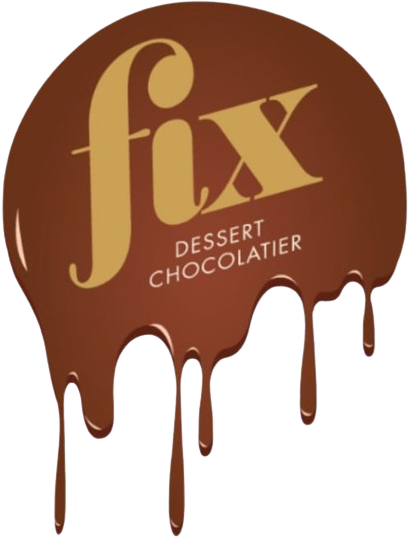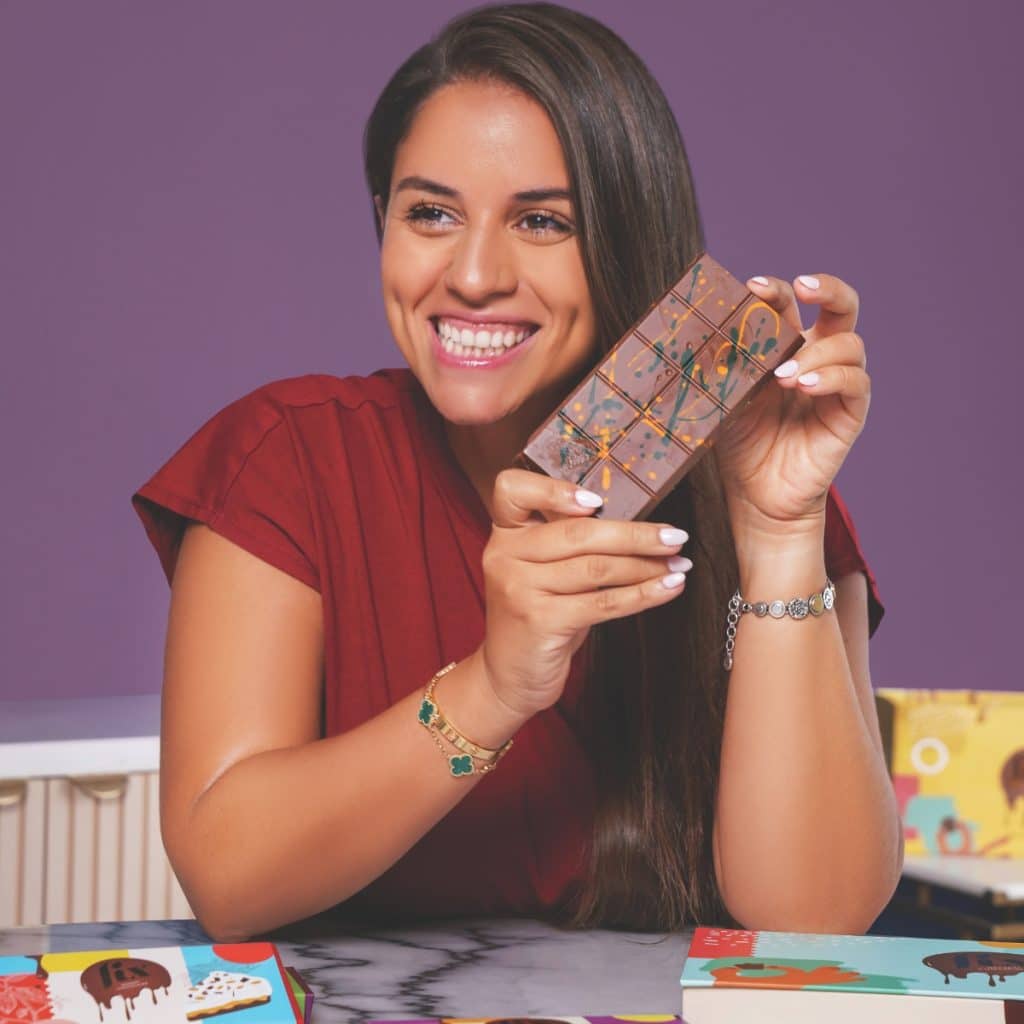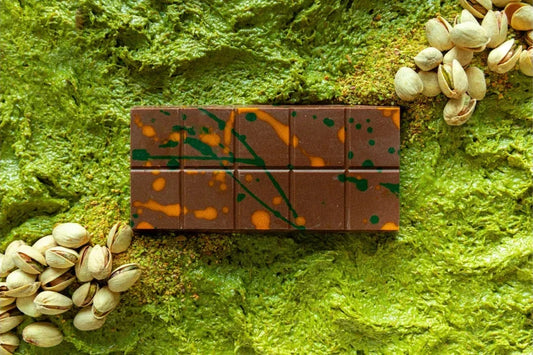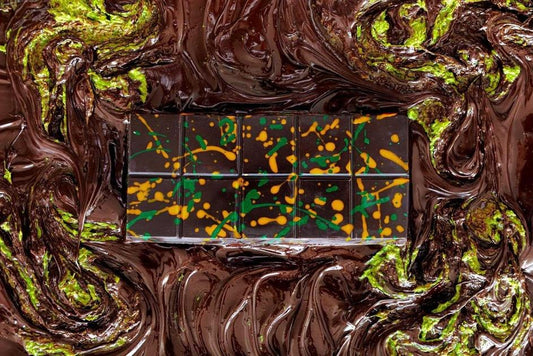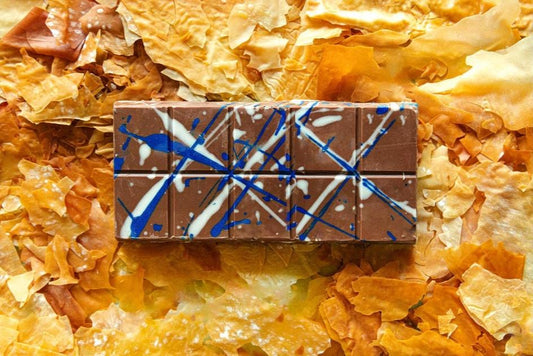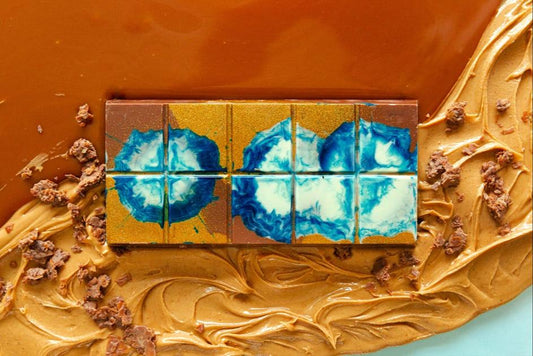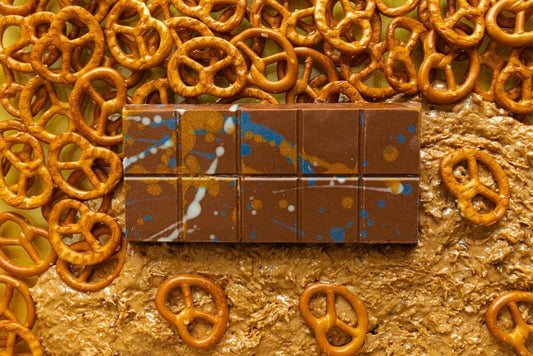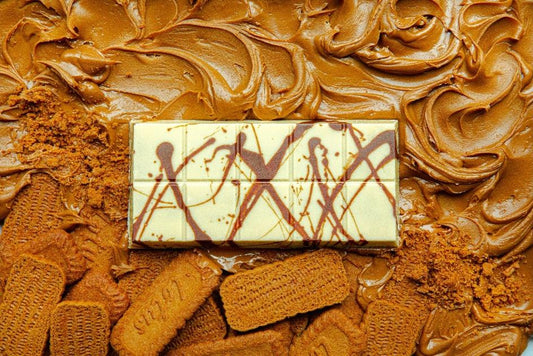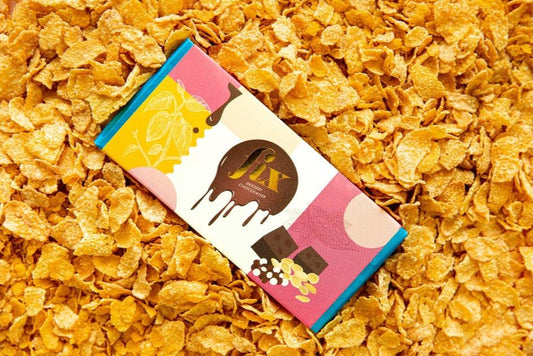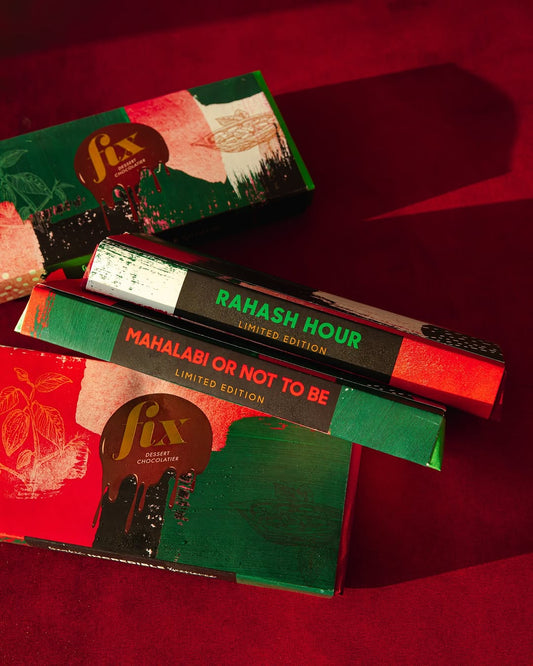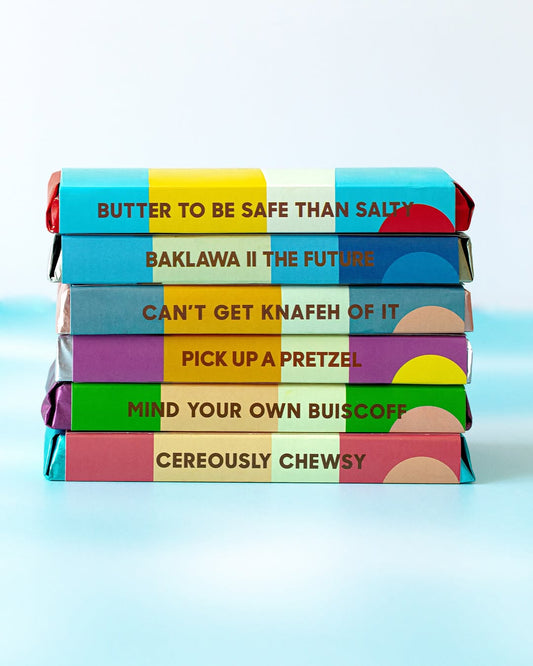“Can’t Get Knafeh”: The Viral Dessert That Broke the Internet (Milk & Dark Chocolate Editions)
By Official Fix Dessert Chocolatier
Introduction — a craving that became culture
There are foods you like, foods you love, and then there are foods you can’t get out of your head. Knafeh — the syrup-soaked, cheese-stretched, golden-crunch delight from the Levant — has always lived in that last category for people lucky enough to grow up with it. But when Official Fix Dessert Chocolatier reimagined knafeh with chocolate, something extraordinary happened: it didn’t just become a delicious crossover, it became a moment. A viral moment. A shared obsession. A dessert people stood in line for, filmed, and recreated in kitchens around the world. We call it “Can’t Get Knafeh”, and whether you prefer the creamy embrace of milk chocolate or the bold tannic whisper of dark chocolate, this is our love letter to that viral creation.
In this long-form post we’ll tell the full story: where knafeh comes from, why chocolate is such a brilliant companion, how “Can’t Get Knafeh” was born and perfected in our kitchen, and — most importantly — why both milk and dark chocolate options matter. Consider this your deep dive into texture, history, cravings, and culture. Consider it the closest thing to tasting the craze without getting your fingers sticky. (But we recommend getting sticky — that’s where the fun is.)
The Origins of Knafeh — simple, ancient, glorious
Knafeh (also spelled kunafeh, knafe, or knafe) is a dessert with roots in the Levant: think Palestine, Lebanon, Jordan, and parts of Syria. For centuries it has been a staple at breakfasts, family gatherings, and festive tables. It is simple in concept — thin shredded pastry (kataifi), sugar-scented syrup, and a layer of stretchy cheese — but the execution is everything. The pastry needs crispness and golden color; the cheese needs the right degree of elasticity and mild salt; the syrup must be fragrant but not cloying; the balance must sing.
Traditional knafeh is a lesson in contrasts: crunchy pastry and soft cheese, sticky syrup and airy strands, perfume of rose or orange blossom water and the clean dairy note of the filling. It’s a dessert that is both humble and ritualistic: the making, the slicing, the pouring of syrup — each step is communal and sensory.
Over time, chefs and home cooks have riffed on the classic recipe. Some add pistachios for color and crunch, others include cream or ricotta to make it denser. But few, until recently, had dared to pair that delicate knafeh DNA with one of the world’s most powerful flavor forces: chocolate.
Why chocolate? The unexpected, perfect match
Chocolate seems like an unlikely player in the knafeh story at first glance. Knafeh’s roots are dairy and sugar, floral syrups and buttery pastry. Chocolate, on the other hand, arrives with cacao’s bitterness, roast notes, and sometimes tannin-like structure. But the greatest flavor marriages are often surprising ones. Chocolate and knafeh share several affinities that make their union deliciously logical:
- Fat & texture synergy: Knafeh’s melting cheese and buttery pastry love the coating, mouthfeel, and snap that chocolate provides.
- Sweetness control: Chocolate (especially dark) helps balance the syrup-laden sweetness and prevents the dessert from feeling cloying.
- Aroma play: Chocolate adds cocoa aromatics that pair beautifully with rose water and orange blossom — it’s a layering effect, not a takeover.
- Visual drama: A ribbon of chocolate across golden strands is visually magnetic — perfect for social sharing, and, yes, virality.
Once we tested chocolate on knafeh, the chemistry was undeniable. But chemistry is not identical to art. The challenge was to integrate chocolate in a way that preserved knafeh’s soul: the shredded pastry, the soft cheese heat, the perfumed syrup. That’s where the two distinct versions of “Can’t Get Knafeh” — Milk Chocolate and Dark Chocolate — were born.
Birth of “Can’t Get Knafeh” — the Official Fix story
At Official Fix Dessert Chocolatier we obsess over texture. We obsess over proportion. We obsess over the handshake between the heat of the oven and the coldness of the cheese, the precise viscosity of syrup, and the temper of chocolate. Our team is a blend of pastry nerds and chocolate obsessives; we love the classics, but we are not shy about tinkering. The idea to bring chocolate to knafeh started as an experiment with leftover couverture — just a drizzle, an accent. The first iteration was small, playful, and immediately addictive.
From there, we went into rapid prototyping. We tried:
- Drizzling vs. layering chocolate.
- Infusing syrups with cacao nibs.
- Using different cheeses (akkawi, mozzarella, ricotta) to see which provided the best stretch and mouthfeel alongside chocolate.
- Testing milk, semisweet, and various dark chocolate percentages to find the emotional center for both indulgent and sophisticated eaters.
What emerged were two distinct lovers’ versions of knafeh: one that leans on the cozy universality of milk chocolate, and one that nods to the refined, adult palate through dark chocolate. Both respected knafeh’s character, and both invited new ways to eat and share the dessert. Then, we posted one on social media.
The rest is what people call “viral.” But virality is a useful word that masks a simpler truth: people saw something beautiful, they recognized its deliciousness, and they wanted to try it. Videos of the melting cheese pull coupled with molten chocolate, the crunch of kataifi, and the audible pour of syrup made for perfect short-form content. Orders surged. Creators filmed their first bites. The internet, generous and hungry, decided that knafeh + chocolate = modern obsession.
Milk Chocolate Magic — comfort, nostalgia, and creamy joy
The Milk Chocolate edition of “Can’t Get Knafeh” is the dessert you order when you want a hug in pastry form. It’s approachable and familiar: milk chocolate’s round sweetness amplifies the warm, buttery identity of knafeh and makes the whole bite feel like childhood wrapped in golden threads.
Flavor profile
Milk chocolate brings creamy lactose notes, a gentle caramelized sugar quality, and low bitterness. When layered with knafeh:
- The milk chocolate’s milk fat integrates with the cheese’s richness, creating a luscious, almost caramel-cream mouthfeel.
- Its lower cacao intensity leaves room for the floral syrup and the toasted kataifi without overwhelming them.
- Where dark chocolate can elevate and contrast, milk chocolate comforts and completes.
Texture & temperature play
Texture is knafeh’s language, and milk chocolate is fluent. The contrast between the crisp kataifi and the soft cheese filling is accentuated when a thin, slightly cooled ribbon of milk chocolate snaps and then melts on the tongue. Serve warm and the milk chocolate softens into cream; serve slightly cooler and the chocolate provides a pleasing snap against the strand’s crunch.
Pairings — what to drink and what to serve it with
Milk chocolate knafeh thrives with things that enhance comfort and nostalgia:
- Coffee: A milky cappuccino or a smooth latte. The milky foam mirrors the dessert itself and creates a comforting loop between cup and plate.
- Tea: Cardamom or cinnamon-spiced black tea; even a light, floral green tea works if you want a lighter counterpoint.
- Fruit: Fresh berries (strawberry, raspberry) add a bright acid contrast that cuts the richness without stealing the show.
- Wine & Drinks: Low-tannin red like Beaujolais or a slightly sweet fortified wine like a tawny port can be delightful.
Customer stories & the emotional hook
People tell us they order the milk chocolate version after certain life moments: to celebrate a small victory, as a treat after a long workday, or as a way to relive a childhood memory of chocolate spread on warm bread. One customer wrote to say she ordered it for her grandmother’s 80th birthday; when her grandmother tasted it, she laughed, saying it reminded her of a simpler dessert but one that felt “dressed up.” That’s the power of the milk chocolate version — it’s immediately accessible and emotionally warming.
Why milk chocolate works for beginners
Not everyone is ready for the sophisticated bite of dark chocolate. Milk chocolate gently invites first-timers into the knafeh world. Its softness reduces the perceived intensity of unfamiliar textures and flavors and increases sharing — which, of course, fuels word-of-mouth and virality. If you’re introducing someone to knafeh for the first time, the milk chocolate “Can’t Get Knafeh” is a brilliant ambassador.
Dark Chocolate Decadence — bold, structured, unforgettable
The Dark Chocolate edition of “Can’t Get Knafeh” is for people who want contrast, depth, and a serious flavor conversation. Dark chocolate introduces bitter, roasted, and tannic notes that play against the dessert’s floral syrup and salty cheese, creating a multi-layered sensory experience.
Flavor profile
Dark chocolate’s higher cacao content offers:
- Bitterness that juxtaposes the syrup’s sweetness.
- Roasted notes that add complexity and a savory edge, emphasizing the dairy’s creaminess more than overt sweetness would.
- A lingering finish that invites slow savoring — this is a dessert that rewards patience and attention.
Texture & the notion of “adult” indulgence
Dark chocolate often has a firmer snap and a slower melt. When you pull a string of cheese through dark chocolate-streaked kataifi, there’s a moment where the bitter cocoa perfume and syrup sweetness are separated by the cool, saline dairy. That contrast is thrilling. The dark chocolate version asks for quiet appreciation: savor it, don’t rush it.
Pairings — elevated and unexpected matches
Dark chocolate knafeh pairs beautifully with beverages and flavors that respect its intensity:
- Espresso or ristretto: Intense coffee resonates with dark chocolate’s roast notes and the syrup’s caramel.
- Spirits: A neat single-malt whisky or a citrus-forward amaro can be transformative.
- Nuts & Seeds: Roasted pistachios or toasted hazelnuts accentuate cacao’s nutty undertones and add extra crunch.
- Wine: Dry fortified wines or robust red blends with soft tannins complement rather than compete.
Customer stories & moments of discovery
Customers describe the dark chocolate version as the dessert they order when they want to feel “grown up” about indulgence. It’s popular among people who typically avoid overly sweet desserts but still crave a dramatic end to a meal. One reviewer described their first bite as “a mini revelation” — dark and bright and somehow grounding in the same mouthful.
Why dark chocolate is a cultural bridge
Dark chocolate invites connoisseurship. It opens knafeh to audiences who prize complexity and subtlety, including coffee and wine aficionados. This version helps the dessert cross café menus, dinner party menus, and tasting menus — expanding knafeh’s cultural footprint beyond its traditional settings without losing its heart.
Milk vs. Dark — the delicious showdown
Milk and dark chocolate versions are not opponents so much as siblings: one is the warm hug, the other is the compelling argument for slow eating. Let’s break down the differences cleanly so you can choose based on mood, company, or craving.
Flavor comparison
- Sweetness: Milk is sweeter and rounder; dark is more acidic and bitter.
- Texture: Milk is creamier and faster-melting; dark is firmer with a more pronounced snap.
- Aromatic profile: Milk reads as caramel & dairy; dark reads as roast, coffee, and dried fruit depending on cacao percentage.
Who chooses which?
- Milk chocolate lovers: Those who want comfort, nostalgia, or to introduce someone to knafeh gently. Families and casual dessert orders often pick milk.
- Dark chocolate fans: Those seeking complexity, less sugar, or a dessert that pairs with an after-dinner drink. Coffee lovers and adventurous palates lean dark.
Which one wins on social media?
Both. Visuals favor milk chocolate for its glossy, flowing ribbons and approachable look; but dark chocolate drives conversation among aficionados and creators who love slow, cinematic bites. Creators often film both versions side by side, and that split-screen comparison becomes its own content: which side melts first? which snap sounds better? Both versions feed different content niches, which helped broaden the original post’s reach.
Behind the scenes at Official Fix — craftsmanship, sourcing, and technique
We don’t believe in gimmicks; we believe in process. Making “Can’t Get Knafeh” at scale while preserving the moment requires three things: attention to ingredients, disciplined process control, and a love for small details.
Ingredients — sourcing that matters
Our kataifi pastry is made fresh to order: thin, buttery, and capable of that golden crisp everyone craves. For the cheese, we source high-quality, low-salt cheeses that stretch without becoming greasy. For chocolate, we use couverture — properly tempered and high-quality — so that both milk and dark versions have clean snaps, proper gloss, and perfect melt behavior.
Syrup is a particular obsession. Too thin and it won’t cling; too thick and it gummifies the bite. We flavor our syrups with subtle orange blossom or rose water — not to dominate, but to echo the dessert’s heritage.
Technique — where artisanship shows
Temperature control is everything. We assemble the kataifi, cheese, and chocolate precisely, then bake at a carefully measured heat so the kataifi crisps and the cheese heats through without separating. We finish with syrup after the pastry comes out of the oven, letting the temperature differential do the magic of syrup absorption without sogginess. Finally, we temper the chocolate and either drizzle it while the dessert is hot (for a molten effect) or add a tempered layer that cools into a glossy ribbon.
Scaling the craft
When something goes viral, the temptation is to churn it out as fast as possible. We scaled deliberately: training staff, documenting timing, and creating quality checks. That way, the 50th order of the day has the same amour as the first. Because a viral dessert loses reputation faster than it gains it, consistency became a moral imperative.
The Viral Phenomenon — how a dessert becomes a movement
Something is viral when it is easily repeatable, visually striking, and emotionally resonant. “Can’t Get Knafeh” hit all three. But there are deeper reasons it traveled so fast:
1. Sensory theatre
Short-form video thrives on sensory moments: the cheese pull, the syrup pour, the chocolate crack. Knafeh + chocolate provides multiple such moments in 15–30 seconds of footage. People stopped scrolling.
2. Cultural storytelling
Food that carries cultural weight often spreads faster because it’s not just about flavor — it’s about identity. For Middle Eastern communities, it felt like a contemporary homage that honored tradition. For others, it felt like an exotic entry point that was accessible. The dessert built bridges.
3. Shareability & recreation
Creators love recreating things. “Can’t Get Knafeh” was visually distinct yet recreatable at home (or at least doable enough to attempt), leading to reaction videos, remakes, and collaborations between food creators and chocolatiers.
4. Timing
Viral moments are also about timing. People in digital spaces wanted joyful, sharable food moments and this dessert arrived like a gift. Our marketing team nudged the moment with well-timed posts, behind-the-scenes content, and creator partnerships, but the true engine was community curiosity and delight.
Cultural Fusion & Global Appeal — beyond novelty to respect
One worthwhile conversation around “Can’t Get Knafeh” is the balance between innovation and respect. Fusion food can sometimes feel shallow — a gimmick or a cultural mismatch. We approached chocolate-knafeh with reverence for knafeh’s heritage. Our goal was never to replace the classic but to build a branch on its tree that people could climb.
That approach resonated with diaspora communities who appreciated a dessert that acknowledged tradition while bringing it into new contexts. It also resonated with global audiences who saw it as an entry point into Middle Eastern sweets. The result: knafeh’s audience expanded without silencing its origin story.
Diaspora & belonging
In messages we received, people often talked about memory. Some said the dessert reminded them of home but with a twist — a taste that let them share their culture with friends in a way that felt contemporary. Food is one of the most powerful mediums for belonging, and “Can’t Get Knafeh” amplified that effect.
The Obsession Factor — why you really “can’t get” knafeh
Let’s talk biology and psychology for a second. Why do we obsess over certain foods? Texture variety is a huge driver: crunchy + soft + syrupy creates a pleasurable sensory contrast. Secondly, novelty matters: we pay attention to the unexpected. Thirdly, social proof and scarcity: when something is scarce or newly trending and everybody is talking about it, our desire ramps up.
“Can’t Get Knafeh” checks all those boxes. It’s texturally exciting, it’s a surprising combination, and the viral context increases perceived scarcity and desirability. That combination fuels repeat orders and the compulsion to come back — to recreate the feeling of discovery again and again.
How to Order & Enjoy — tips from our pastry chefs
If you’re buying “Can’t Get Knafeh” from our shop (or trying to recreate it at home), here are chef-recommended tips to get the best experience.
Serving temperature
- Serve warm but not boiling — aim for the point where the cheese is molten and the chocolate is glossy but not completely liquified.
- If you prefer a firmer chocolate ribbon, let it rest 2–3 minutes after assembly so tempered chocolate can set slightly.
Eating method
Use a fork for composed plates, but don’t be shy about tearing off a piece with your hands for the full experience. The tactile sensation is part of the pleasure.
Storage & reheating
Leftovers are best reheated gently in an oven at low heat to bring back the crispness. Avoid microwave reheating if you can — the kataifi can go soggy and the chocolate may seize.
A mini recipe (adapted for home cooks)
If you want to attempt a simplified home version, here’s a basic framework. This is not our full commercial process, but it will get you deliciously close.
Ingredients (serves 4)
- 300g kataifi pastry, thawed if frozen
- 100g unsalted butter, melted (for brushing)
- 300–400g low-salt stringy cheese (mozzarella or akkawi soaked to reduce salt)
- 150g sugar syrup (1:1 sugar and water, flavored with a splash of orange blossom or rose water)
- 150g chocolate (milk or dark, chopped)
Method
- Preheat oven to 190°C (375°F).
- Gently separate the kataifi and brush liberally with melted butter; press half the kataifi into a lined baking dish to form a base.
- Add the cheese layer, then cover with remaining kataifi. Press gently and brush the top with butter.
- Bake 20–25 minutes until golden and crisp.
- Warm the syrup and drizzle it over the hot pastry in a slow, even pour.
- For the chocolate: if you want a molten effect, drizzle warm melted chocolate immediately. For a tempered ribbon, let the pastry cool slightly and then drizzle tempered chocolate that will set.
Enjoy immediately. Bonus: finish with chopped roasted pistachios for texture and color.
Marketing & Merchandising Lessons from a Viral Hit
When your product goes viral the marketplace changes quickly — and there are lessons worth sharing for other brands:
1. Be ready to scale without compromising quality
Invest in process documentation and training immediately. Viral demand often collapses a brand if you can’t meet expectation; quality control keeps earned trust.
2. Tell the origin story honestly
People love the “why” behind a dish. Share the craft and the intent. That builds loyalty beyond the first taste.
3. Embrace creators, but set guardrails
Creators will remix your product. Encourage creativity, but provide clear usage guidelines for your brand voice and product integrity.
4. Offer entry points
Having two versions — milk and dark — widened the dessert’s audience. Offering accessible and premium options can help capture a broader market without diluting brand identity.
Frequently Asked Questions (FAQ)
Q: Is “Can’t Get Knafeh” replacing traditional knafeh?
A: Absolutely not. It’s a new branch on an old tree. Our aim is to honor the original while offering a playful, contemporary version. Traditionalists can — and should — still enjoy classic knafeh.
Q: Which chocolate percentage is used for the dark version?
A: We typically use 62–72% cacao dark chocolate to provide structure and roast notes while avoiding an overly dry finish. This percentage range balances bitterness and cocoa complexity with the dessert’s sweet and floral elements.
Q: Are your cheeses halal/vegetarian-friendly?
A: We use cheeses that comply with local dietary standards where applicable. Please check product labels or contact our shop for specific certifications and ingredient sources.
Q: Can I ship this dessert?
A: Due to the textural nature of knafeh, we recommend local pickup or same-day delivery where possible. If you need it shipped, contact our team for specially-packaged options and timing recommendations.
Voices from the community — stories you shared
We have been humbled by the messages, videos, and photos you’ve shared. Three moments stand out:
- The shared first bite: A college student sent a video of his roommate’s surprise after their first taste: a laugh, a tear, and a phone call to their mom. “It tastes like home,” he said.
- The cross-generational table: A family ordered both milk and dark and had a playful “taste-off” between parents and kids. The kids picked milk; the parents championed dark. Everyone agreed to order both next time.
- The creator collab: A pastry creator filmed a slow-motion cheese pull with dark chocolate, and the video got picked up by food editors — a moment that catapulted the dessert into new markets.
These stories remind us why we do what we do — not for virality itself, but for the small human moments that good food helps make possible.
Sourcing & sustainability — the quiet commitments
We don’t shout about our sourcing as loudly as our recipes, but it’s central to our ethos. We aim to:
- Use sustainably sourced chocolate when available.
- Work with dairy suppliers committed to humane practices.
- Minimize food waste by optimizing batch sizes and donating surplus where safe and appropriate.
Our customers increasingly ask about provenance and ethics. Expect more transparency as we scale “Can’t Get Knafeh” in ways that align with those values.
What’s next? The future of knafeh and Official Fix
Food trends come and go, but meaningful innovations endure when they respect source material and open new doors. We see several ways forward:
- Seasonal variations: Think citrus-scented syrups in winter, summer fruit accents, and spice-infused versions for holiday menus.
- Collaborations: Working with coffee roasters, wineries, and spice purveyors to create curated pairing evenings and kits.
- Classroom & workshops: Teaching people how to make their own at-home versions — both for tradition and for creativity.
We are excited to continue listening to you, experimenting respectfully, and offering desserts that spark conversation and comfort in equal measure.
Final Thoughts — an invitation
“Can’t Get Knafeh” is more than a dessert — it’s an idea: that tradition can be honored even when we’re curious, that classics can be playful, and that a perfect bite is worth chasing. Whether you’re the person who reaches for milk chocolate when you crave nostalgia, or the one who orders dark because you love depth, there’s a place for you at our table.
If you want to try both and decide for yourself, we’d be thrilled to send you a paired tasting. Visit our shop at Official Fix Dessert Chocolatier to order the Milk Chocolate or Dark Chocolate “Can’t Get Knafeh” today. Share your first bite with us — tag @officialfixdessertchocolatier — and join the conversation that turned a simple idea into a shared worldwide craving.
Call to Action
Try both editions: Order the Milk Chocolate “Can’t Get Knafeh” if you want something cozy and indulgent. Order the Dark Chocolate “Can’t Get Knafeh” if you’re craving something bold and contemplative. Prefer both? We recommend ordering a tasting pack and discovering which one becomes your obsession.
Visit Official Fix Dessert Chocolatier → Shop “Can’t Get Knafeh”
Credits & acknowledgements
Recipe development and creation by the Official Fix Dessert Chocolatier pastry team. Special thanks to our customers and creator community for sharing videos, feedback, and love.
Appendix — quick reference (for editors)
Below are quick facts you can use for product listings, social captions, or press copy:
- Product name: “Can’t Get Knafeh” — Milk Chocolate edition and Dark Chocolate edition
- Key attributes: kataifi pastry, stretchy cheese layer, perfumed sugar syrup, milk or dark chocolate ribbon
- Serving suggestion: Serve warm; pair milk with latte, dark with espresso or whisky
- Allergens: Contains dairy and gluten; may contain traces of nuts depending on finishing
- Ordering: Best for local pickup or same-day delivery; shipping available with special packaging
Parting note
Thank you for reading this deep dive into one of our proudest creations. Food connects us — across kitchens, screens, and tables. We hope this post brings you closer to the bite that made the world stop scrolling and start tasting. If you try “Can’t Get Knafeh,” tell us how it made you feel. We love hearing which version captures your heart.
— The Official Fix Dessert Chocolatier Team
